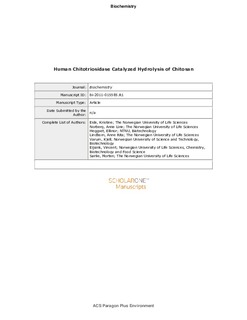Human chitotriosidase-catalyzed hydrolysis of chitosan
Eide, Kristine Bistrup; Norberg, Anne Line; Heggset, Ellinor Bævre; Lindbom, Anne Rita; Vårum, Kjell Morten; Eijsink, Vincent; Sørlie, Morten
Journal article, Peer reviewed
Accepted version
Permanent lenke
http://hdl.handle.net/11250/2462259Utgivelsesdato
2012Metadata
Vis full innførselSamlinger
Sammendrag
Chitotriosidase (HCHT) is one of two family 18 chitinases produced by humans, the other being acidic mammalian chitinase (AMCase). The enzyme is thought to be part of the human defense mechanism against fungal parasites, but its precise role and the details of its enzymatic properties have not yet been fully unraveled. We have studied the properties of HCHT by analyzing how the enzyme acts on high-molecular weight chitosans, soluble copolymers of β-1,4-linked N-acetylglucosamine (GlcNAc, A), and glucosamine (GlcN, D). Using methods for in-depth studies of the chitinolytic machinery of bacterial family 18 enzymes, we show that HCHT degrades chitosan primarily via an endoprocessive mechanism, as would be expected on the basis of the structural features of its substrate-binding cleft. The preferences of HCHT subsites for acetylated versus nonacetylated sugars were assessed by sequence analysis of obtained oligomeric products showing a very strong, absolute, and a relative weak preference for an acetylated unit in the −2, −1, and +1 subsites, respectively. The latter information is important for the design of inhibitors that are specific for the human chitinases and also provides insight into what kind of products may be formed in vivo upon administration of chitosan-containing medicines or food products.
